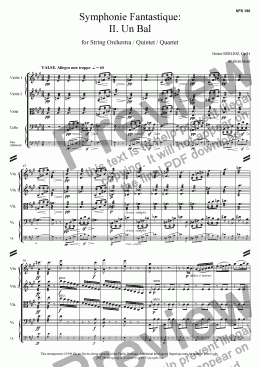Ready to print
You have already purchased this music, but not yet printed it.
This page is just a preview and does not allow printing. To print your purchase, go to the My purchases page in your account and click the relevant print icon.
Symphonie Fantastique - 2. Un Bal

Already purchased!
You have already purchased this score. To download and print the PDF file of this score, click the 'Print' button above the score. The purchases page in your account also shows your items available to print.
This score is free!
Buy this score and parts
Symphonie Fantastique - 2. Un Bal
$13.95
$3.95
from $2.00
Preview individual parts:
Instant download
You are purchasing high quality sheet music PDF files suitable for printing or viewing on digital devices.Berlioz composed this work in 1830 and conducted the first performance in Paris on December 5 of that same year. He revised it in 1832 and added two cornets to the instrumentation in 1845.
Berlioz the composer was a full-blown Romantic, whose infatuation-at-first-sight with a pretty British ing?nue named Harriet Smithson influenced his Fantastic Symphony. Miss Smithson came to Paris to play Shakespeare, Berlioz's hero (along with Virgil, Goethe, Gluck, Beethoven, Lord Byron, and Victor Hugo). Harriet was "The Beloved" of his programme fantastique. "A young musician of morbid sensibility…in a paroxysm of lovesick despair" attempts suicide, but takes only enough laudanum to induce hallucinations, in which his Beloved appears as a recurring melody with several personalities, finally as a bacchante at a satanic ritual. Despite the lurid scenario, Berlioz's five-movement structure owes more to Beethoven's Pastoral Symphony than anyone seems to have noticed at the time, or, for that matter, since. Where Beethoven whipped up a storm, Berlioz created a mob scene that concludes with the protagonist's death: his decapitated head bounces into a waiting basket pizzicato. In the finale, Berlioz went far beyond Beethoven's merrymaking peasants; he created a witches' sabbath, without precedent in music before 1830. Along with liberating orchestral color, he overthrew the tyranny of bar-lines, downbeat accents, and academic dogma.
"A Ball" (Allegro non troppo, A major) is the waltz without a trio, although a contrasting section in the original piece in F major has unison flute and oboe playing the Beloved's theme.
This arrangement has references to the id?e fixe removed to make it a "stand alone" piece. It comes with an optional bass part for use with string orchestra.



